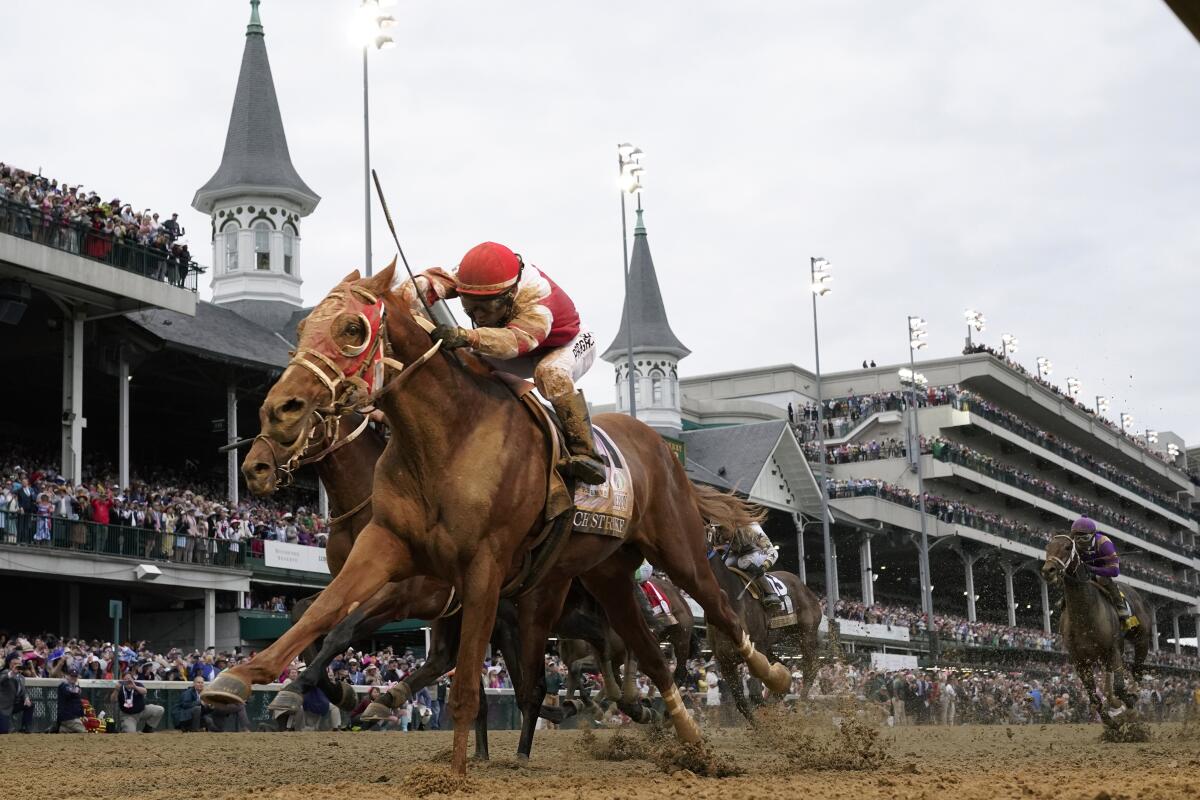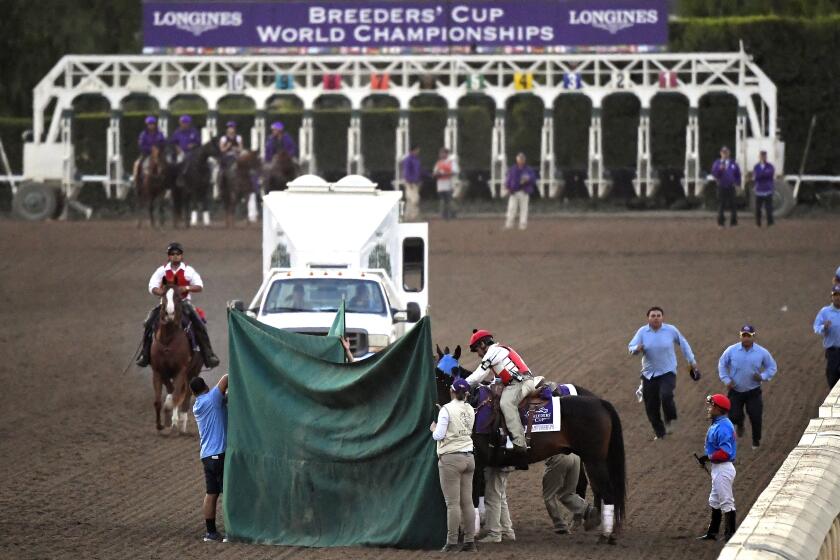Investigation into Churchill Downs horse deaths finds no singular cause

- Share via
An investigation into the dramatic rise in deaths at Churchill Downs around the Kentucky Derby was released on Tuesday with a very familiar answer — we don’t know what happened.
The Horseracing Integrity and Safety Authority (HISA) released its 197-page report on Churchill Downs, filled with graphs, charts and all the trappings of a thorough examination. The only thing it lacked was a conclusion.
“The absence of a singular explanation for recent equine fatalities at several racetracks across the country is extremely frustrating for the entire sport of thoroughbred racing, for fans and the public, and also for HISA,” according to the report. “Consequently, action must be taken in reaction to what we know and what we do not know, for the welfare of thoroughbred horses.”
Seven horses died at Churchill Downs in the 10 days leading up to the Kentucky Derby, two on Derby day. Two more horses died before racing, but not training, was suspended at the iconic Louisville track and moved to Ellis Park, two hours away in Kentucky. The move was made at the recommendation of HISA.
The horse death toll at Churchill Downs grew to 12 in the last month when Kimberley Dream, a 7-year-old mare, died on the track in the first race Saturday.
HISA recommended several actions, including the perfunctory forming of new committees. Its six-point plan is composed of these recommendations:
—Create a track surface advisory group.
—Create a “blue ribbon” committee that would look at having more racing on synthetic surfaces.
—Work with industry leaders to create more data sources that will lead to academic analysis and predictive analytics to help find the causes of horse fatalities.
—Additional veterinary protocols through advance screenings.
—Explore changes to veterinary protocols.
The size of a race horse and its natural instincts make it nearly impossible to survive serious injuries at the track, but many are trying to improve the odds.
—Enforcing rules around fatality and injury reporting and necropsies. California and New York have been leaders in this, while Kentucky keeps much of this information under a cloud of secrecy.
“Obviously, if we had one smoking gun, one clear answer, that would be simpler and you can put all of your resources dealing with that one issue,” said Lisa Lazarus, head of HISA. “That being said, the fact that it is multifactorial gives us an opportunity so we can’t just kick the can down the road.
“Race tracks and breeders and consigners all have to be behind real change. Even though one factor would have been easier, it gives the opportunity to give a really comprehensive review. Nothing is off the table, and no stakeholder group can decline to participate.”
Nationally, the amount of horse racing deaths is down precipitously from years past, but the public intolerance for equine fatalities far outpaces the reduction.
The country became aware that horses routinely die racing and training in 2019 when Santa Anita had a huge number of fatalities early in its winter season. The track eventually closed for about three weeks under the pressure of public scrutiny. The death toll at the end of the six-month meeting was 30.
Along the way, the Stronach Group, which owns Santa Anita and other tracks, aggressively pursued equine safety and instituted many measures, including vigorous pre-race screening. Most of the ideas were adopted by the California Horse Racing Board. Since 2019, deaths in the state have been reduced by 55%. Mitigating that is a reduction of racing in the state due to an ever-shrinking horse population.
The horse deaths at Churchill Downs surpassed those of Santa Anita over any one-month period.
In addition to the fatality spike at Churchill Downs this year there were notable increases, over defined periods of time, at Laurel Race Course in Maryland and Saratoga in New York. HISA is conducting a similar investigation into the Saratoga spike.
People for the Ethical Treatment of Animals was quick to react to the HISA report on Churchill Downs.
“The HISA report is disgraceful, incompetent and forgiving of the unforgivable — the deaths of 12 horses in just a few weeks this year,” said Kathy Guillermo, senior vice president of PETA. “If HISA can’t determine a common reason for these deaths, are they admitting that racing is simply fatal by definition? If so, it must end.
“Prevention of deaths is not some Agatha Christie mystery and the HISA report missed by design or failure the two most obvious ways among others that PETA has long pointed out would save the horses’ lives: a synthetic surface to replace the deadly dirt track, and a CT Scan screening system to detect bone injuries before a race. We don’t need more necropsy report pseudo-analyses to know this. The racing industry’s own studies confirm that 90% of horses who suffer catastrophic breakdowns have pre-existing injuries, which low-radiation, standing CT imaging would pick up. Everyone already understands the solution. Just do it.”
Churchill Downs validated the report from HISA.
“We appreciate the diligent investigation and analysis from the team at HISA,” said Darren Rogers, senior director of communications for Churchill Downs. “We have already implemented several of the recommendations listed in the report as well as additional internal key safety enhancements in time for the opening of our September meet. Churchill Downs will continue to explore and invest in initiatives that support equine safety as our highest priority.”
There is little doubt that horse racing and animal rights activists realize that for horse racing to survive, horse deaths have to continue to be reduced.
“I know a lot of people say can we ever get to zero fatalities,” Lazarus said. “I can’t make guarantees to percentages and numbers, but our goal will always be to get to zero. We will keep working and keep trying until we get to zero.
“I think we are in a different place now. I think the industry has recognized unless we work together to genuinely work together to make changes that the industry is in jeopardy. So, I think you see a real commitment among stakeholders, and now is the time to put everything we have to put everything together to minimize the risks.”
More to Read
Go beyond the scoreboard
Get the latest on L.A.'s teams in the daily Sports Report newsletter.
You may occasionally receive promotional content from the Los Angeles Times.













